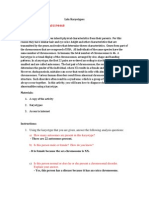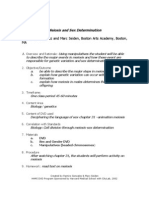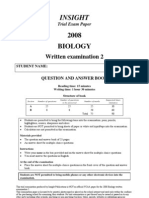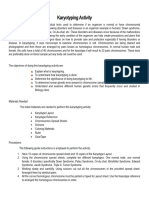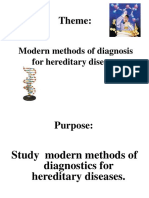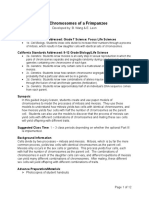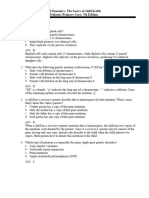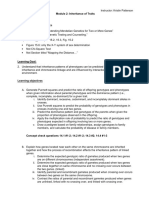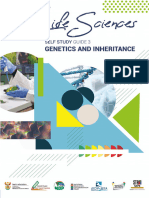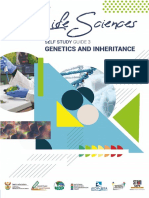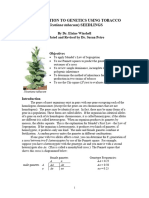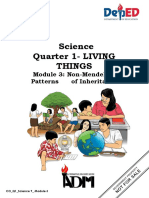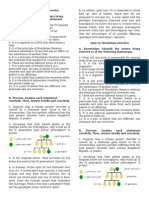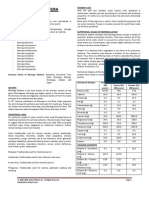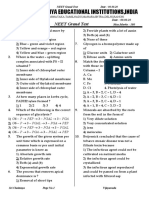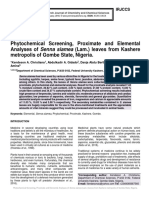Karyotyping
Karyotyping
Uploaded by
Medina ZahicCopyright:
Available Formats
Karyotyping
Karyotyping
Uploaded by
Medina ZahicOriginal Description:
Copyright
Available Formats
Share this document
Did you find this document useful?
Is this content inappropriate?
Copyright:
Available Formats
Karyotyping
Karyotyping
Uploaded by
Medina ZahicCopyright:
Available Formats
APPENDIX B
Karyotyping
Introduction
You are a genetic counselor whose job is to discuss with expecting parents
any genetic disorder that may affect their child. Currently, you are working
with two couples. The two expectant mothers are over thirty-five and are
concerned that their unborn children may have chromosomal
abnormalities. You have been given a chromosome spread of each of the
children. For each couple, you must construct and analyze a karyotype. In
addition, you will be expected to give each couple a brief explanation of the
test results, including the characteristics of any genetic disorder that may
affect their unborn child.
Purpose
To connect and analyze several karyotypes.
Materials
Glue (1)
Ruler (1)
Scissors (1 pair)
Procedure
1.
Obtain two different chromosome spread sheets from your teacher.
2.
Cut out the chromosomes of one of the chromosome spread sheets.
3.
Arrange the chromosomes into 22 pairs on the karyotype template.
The chromosomes of each pair should be the same length (use a
ruler!) and have the same centromere position. They should also
have similar banding patterns. The two remaining chromosomes are
the sex chromosomes. Since the X and Y chromosomes are
nonhomologous, they will not have similar lengths, centromere
positions or banding patterns. (Refer to the normal human
karyotype.)
4.
Now, place the chromosomes in order, with the longest pair at
position 1, the shortest at position 22, and the sex chromosomes at
position 23.
5.
Finally, glue each chromosome into position. Be sure to label your
karyotype according to the chromosome spread you were given.
6.
Use your constructed karyotype # 1 to answer the analysis question 1.
7.
Repeat steps 1 to 5 for your second chromosome spread sheet.
8.
Use your constructed karyotype #2 to answer the analysis question 2.
BIOLOGY 3201 CURRICULUM GUIDE
Chromosome Spread Sheets (2)
Karyotype Templates #s 1 and 2
139
APPENDIX B
Analysis
1.
Analyze karyotype #1 to determine if a chromosomal abnormality
exists.
a)
b)
c)
2.
Analyze karyotype #2 to determine if a chromosomal abnormality
exists.
a)
b)
c)
Further Analysis
140
Will the child have a genetic disorder?
Explain the reason for your answer.
Using the student chart, determine which genetic complication
will affect the child.
Will the child have a genetic disorder?
Explain the reason for your answer.
Using the student chart, determine which genetic complication
will affect the child.
3.
Describe two procedures used by genetic counselors to obtain a DNA
sample used for karyotyping.
4.
Describe two other techniques used to examine the developing fetus
for abnormalities.
5.
Write a letter to one of the expectant couples, informing them of the
results of the genetic tests. The letter must include the name of the
genetic disorder that affects their child and the characteristics of the
disorder. Since you are a professional, be sure that you use clear
language to communicate the test results.
BIOLOGY 3201 CURRICULUM GUIDE
You might also like
- The Costs of Eating Disorders Final OriginalDocument76 pagesThe Costs of Eating Disorders Final Originalmadequal2658No ratings yet
- Biology Science For Life With Physiology 5Th Edition Belk Solutions Manual Full Chapter PDFDocument35 pagesBiology Science For Life With Physiology 5Th Edition Belk Solutions Manual Full Chapter PDFCassieYangiosx100% (18)
- DM TestsDocument23 pagesDM TestsMunaNo ratings yet
- Genetics ProblemsDocument14 pagesGenetics Problemsafaflotfi_1556964590% (2)
- O Level Biology Practice Questions And Answers: Heredity And Molecular GeneticsFrom EverandO Level Biology Practice Questions And Answers: Heredity And Molecular GeneticsNo ratings yet
- Eye Dictionary PDFDocument421 pagesEye Dictionary PDFFandy Rachmad DewantoroNo ratings yet
- Appendix B: Karyotyping and Genetic DisorderDocument14 pagesAppendix B: Karyotyping and Genetic DisorderMedina ZahicNo ratings yet
- Making Karyotypes: Read The Entire Investigation. Then Answer The Following QuestionsDocument7 pagesMaking Karyotypes: Read The Entire Investigation. Then Answer The Following QuestionsJohn OsborneNo ratings yet
- Lab 5 KaryotypesDocument2 pagesLab 5 Karyotypesapi-224251981No ratings yet
- Karyotype Lab PDFDocument5 pagesKaryotype Lab PDFwelfredo yuNo ratings yet
- Chok MahDocument7 pagesChok Mahryanramroyeras972No ratings yet
- Secondary Biology Unit Plan: Genetic Inheritance 1Document26 pagesSecondary Biology Unit Plan: Genetic Inheritance 1api-418022315No ratings yet
- Recuperation Workshop Science 9th GradeDocument5 pagesRecuperation Workshop Science 9th GradeJUAN CAMILO JIMENEZNo ratings yet
- Meiosis Sex DeterminDocument13 pagesMeiosis Sex DeterminAnkush ChopraNo ratings yet
- Lab Exer 4 Sex Chromosomes and Sex DeterminationDocument2 pagesLab Exer 4 Sex Chromosomes and Sex DeterminationmichaeljamesbalanoNo ratings yet
- CSIR Sample ProblemsDocument8 pagesCSIR Sample ProblemsRanjani KollurNo ratings yet
- Chapter 10 Active Reading GuideDocument5 pagesChapter 10 Active Reading GuidedorothyNo ratings yet
- 10A - Bio - All - Worksheets - Quizzes 4Document49 pages10A - Bio - All - Worksheets - Quizzes 4Farzad FarhadNo ratings yet
- Biol-104l Ex5 Group1Document10 pagesBiol-104l Ex5 Group1Christian LabisNo ratings yet
- Lab 06 Handout PDFDocument9 pagesLab 06 Handout PDFRoxana MatacheNo ratings yet
- DragonGenetics2Protocol PDFDocument6 pagesDragonGenetics2Protocol PDFMatthew PettusNo ratings yet
- 2008 Biology: InsightDocument23 pages2008 Biology: InsightXavier GavinNo ratings yet
- Karyotyping Lesson Plan - Biology 30sDocument3 pagesKaryotyping Lesson Plan - Biology 30sapi-395453264No ratings yet
- 10th Week InheritanceDocument9 pages10th Week InheritanceJude Daniel AquinoNo ratings yet
- KARYOTYPE OutputDocument5 pagesKARYOTYPE Outputashrieldave2007No ratings yet
- 3 - Karyotyping LabDocument17 pages3 - Karyotyping LabEd HouNo ratings yet
- Karyotype ActivityDocument4 pagesKaryotype ActivityRut ChristineNo ratings yet
- 2019 ExamDocument27 pages2019 ExamCheng FuNo ratings yet
- Topic LessonDocument48 pagesTopic LessonAbl AblNo ratings yet
- Tugas Menjawab Soal Di Buku Campbell (Rangkaian Tugas Mandiri 3)Document6 pagesTugas Menjawab Soal Di Buku Campbell (Rangkaian Tugas Mandiri 3)Afif AzizNo ratings yet
- Mitosis Meiosis Teach PrepDocument11 pagesMitosis Meiosis Teach Prepcyberbat2008No ratings yet
- 234-951 Week 2 Reading Assignment 1 - DNA ReplicationDocument5 pages234-951 Week 2 Reading Assignment 1 - DNA ReplicationgursahilpurbaNo ratings yet
- Lacerna, Roselyn T. Lab Activity WorksheetDocument6 pagesLacerna, Roselyn T. Lab Activity WorksheetRoselyn LacernaNo ratings yet
- (Student Handout) Human KaryotypingDocument8 pages(Student Handout) Human Karyotypingammaz.asif2009No ratings yet
- Chromosomes of FrimpanzeeDocument12 pagesChromosomes of FrimpanzeeAnonymous ZrrnPJf6No ratings yet
- Chapter 03: Genetic and Genomics: The Basics of Child Health Garzon Maaks: Burns' Pediatric Primary Care, 7th EditionDocument3 pagesChapter 03: Genetic and Genomics: The Basics of Child Health Garzon Maaks: Burns' Pediatric Primary Care, 7th EditionHelen Ugochukwu100% (1)
- Assignment-1 Genetics 341Document4 pagesAssignment-1 Genetics 341damionsimmons10No ratings yet
- ReebopsDocument12 pagesReebopsapi-249411091No ratings yet
- Unit 3 Genetic Algorithm FinalDocument32 pagesUnit 3 Genetic Algorithm FinalDr.KalaivazhiNo ratings yet
- Human KaryotypingDocument7 pagesHuman KaryotypingEditorialranged CartoonistoplaneNo ratings yet
- Karyotypes - An Argument-Driven Inquiry Lab ActivityDocument5 pagesKaryotypes - An Argument-Driven Inquiry Lab Activityapi-249102379No ratings yet
- Module 2: Inheritance of Traits ResourcesDocument2 pagesModule 2: Inheritance of Traits ResourcesMarcus RecioNo ratings yet
- Life-Sciences-Genetics-and-Inheritance (1)Document52 pagesLife-Sciences-Genetics-and-Inheritance (1)Siyabusa NdzimbovuNo ratings yet
- UntitledDocument52 pagesUntitledIndiphile SululuNo ratings yet
- 234-951 Tutorial 1 Problem Set For Canvas (No Answers)Document6 pages234-951 Tutorial 1 Problem Set For Canvas (No Answers)gursahilpurbaNo ratings yet
- Genetics Lab Exercise 4.DocxDocument1 pageGenetics Lab Exercise 4.DocxRose An CorbillonNo ratings yet
- Karyotype Activity GoodDocument12 pagesKaryotype Activity GoodSATZU MALAKASNo ratings yet
- This Material Is Not For Sale: Bio 30: GeneticsDocument3 pagesThis Material Is Not For Sale: Bio 30: GeneticsJansen AbadNo ratings yet
- Tugas Individu 1C. Guiding QuestionsDocument16 pagesTugas Individu 1C. Guiding QuestionsAmelia Sukma Wati325No ratings yet
- Sci8 Q4 M3 Mendelian-Genetics-1Document28 pagesSci8 Q4 M3 Mendelian-Genetics-1CarlJOPYRONo ratings yet
- DEMO Law of SegregationDocument112 pagesDEMO Law of SegregationJESSIE SALINASNo ratings yet
- Activity Sheet Module 2Document13 pagesActivity Sheet Module 2Danica FayeNo ratings yet
- Week 4 ExperimentDocument11 pagesWeek 4 ExperimentKomal KhanNo ratings yet
- Mendel Tobacco AssignmentDocument6 pagesMendel Tobacco Assignmentjsmith2000k20No ratings yet
- Genetics StationsDocument32 pagesGenetics Stationstiffany.walkerNo ratings yet
- Karyotype Activity UpdateDocument6 pagesKaryotype Activity Updateapi-504578754No ratings yet
- Unit 8Document114 pagesUnit 8ShekharNo ratings yet
- Science 9 - Q1 - Mod3 - Non Mendelian Patterns of Inheritance - VerFinalDocument32 pagesScience 9 - Q1 - Mod3 - Non Mendelian Patterns of Inheritance - VerFinalRica Mae A. AmpilNo ratings yet
- Quiz On Mendelian GeneticsDocument2 pagesQuiz On Mendelian GeneticsslytheraineNo ratings yet
- Lesson 2 Meiosis-Performance TaskDocument10 pagesLesson 2 Meiosis-Performance TaskaceNo ratings yet
- Eoc Review PacketDocument12 pagesEoc Review Packetapi-293001217No ratings yet
- The Genetics of ParenthoodDocument14 pagesThe Genetics of Parenthoodtim100% (1)
- Moringa Fresh Leaf Vs Dried LeafDocument3 pagesMoringa Fresh Leaf Vs Dried LeafAshwani Gaur88% (8)
- Sri Chaitanya Educational Institutions, India: NEET Grand TestDocument5 pagesSri Chaitanya Educational Institutions, India: NEET Grand TestVikash ReddyNo ratings yet
- Liver Biopsy - H. Takahashi (Intech, 2011) WWDocument414 pagesLiver Biopsy - H. Takahashi (Intech, 2011) WWmientweg100% (1)
- The New Trauma Score (NTS) : A Modification of The Revised Trauma Score For Better Trauma Mortality PredictionDocument9 pagesThe New Trauma Score (NTS) : A Modification of The Revised Trauma Score For Better Trauma Mortality PredictionstellaNo ratings yet
- YOUR LIFE JUICE Marketing AssignmentDocument22 pagesYOUR LIFE JUICE Marketing AssignmentSweelin TanNo ratings yet
- Wilma Dapog Flexilink 1mDocument10 pagesWilma Dapog Flexilink 1mTweetie Borja DapogNo ratings yet
- Coronavirus Disease (COVID-19) : The Impact and Role Of: Mass Media During The PandemicDocument3 pagesCoronavirus Disease (COVID-19) : The Impact and Role Of: Mass Media During The PandemicShariz DinoyoNo ratings yet
- Clinical - Bilirubin TestDocument9 pagesClinical - Bilirubin Testbarbie.monster89100% (3)
- Illustrated Objective Toxicology For Veterinary Exams - (WWW - FreeBookBank.net) PDFDocument99 pagesIllustrated Objective Toxicology For Veterinary Exams - (WWW - FreeBookBank.net) PDFAshok BalwadaNo ratings yet
- Profile of Tirzepatide in The Management of Type 2 Diabetes Mellitus: Design, Development, and Place in TherapyDocument13 pagesProfile of Tirzepatide in The Management of Type 2 Diabetes Mellitus: Design, Development, and Place in TherapyDiego Andres Garcia RochaNo ratings yet
- Phytochemical Screening, Proximate and Elemental Analyses of Senna Siamea (Lam.) Leaves From Kashere Metropolis of Gombe State, NigeriaDocument4 pagesPhytochemical Screening, Proximate and Elemental Analyses of Senna Siamea (Lam.) Leaves From Kashere Metropolis of Gombe State, NigeriaPremier PublishersNo ratings yet
- AdimeDocument2 pagesAdimeapi-276849892No ratings yet
- Conventional Breeding of BananasDocument12 pagesConventional Breeding of BananasCédric KENDINE VEPOWONo ratings yet
- Confusion Assessment Method (CAM) - 1Document2 pagesConfusion Assessment Method (CAM) - 1Iris De La CalzadaNo ratings yet
- Final Year ProjectDocument24 pagesFinal Year Projectemmanueloyetola53No ratings yet
- Integumentary SystemDocument61 pagesIntegumentary SystemNicole EncinaresNo ratings yet
- Umibilical Cord - ProlapsDocument22 pagesUmibilical Cord - ProlapsYosuaH.KumambongNo ratings yet
- Human Physiology - The Basis of MedicineDocument2 pagesHuman Physiology - The Basis of MedicineDozzyNo ratings yet
- Test IntegumentaryDocument2 pagesTest IntegumentaryRoshann_Larano_48No ratings yet
- FDAapproves Daybuethefirsttreatmentfor RettsyndromeDocument8 pagesFDAapproves Daybuethefirsttreatmentfor RettsyndromeNeethu Anna StephenNo ratings yet
- Genetics and Heredity CFA Study Guide With AnswersDocument3 pagesGenetics and Heredity CFA Study Guide With AnswersLuisa Maria Maya PalacinoNo ratings yet
- Colorectal Cancer TNM, 8th Edition - UpToDateDocument1 pageColorectal Cancer TNM, 8th Edition - UpToDateamanuelNo ratings yet
- PREDSOL Suppository and Retention Enema: What Is This LeafletDocument4 pagesPREDSOL Suppository and Retention Enema: What Is This Leafletadin74585No ratings yet
- Nursing Process Cellular AberrationDocument21 pagesNursing Process Cellular AberrationrimeoznekNo ratings yet
- Kumpulan Tugas Keperawatan Hiv/ AidsDocument8 pagesKumpulan Tugas Keperawatan Hiv/ Aidsvina hardiyantiNo ratings yet
- Neurologist Doctor Near MeDocument2 pagesNeurologist Doctor Near MesnaayuNo ratings yet
- Community Health Nursing: Prepared By: Michael H. Galon, Man, RNDocument100 pagesCommunity Health Nursing: Prepared By: Michael H. Galon, Man, RNHilda Dacula Ortillo100% (1)









